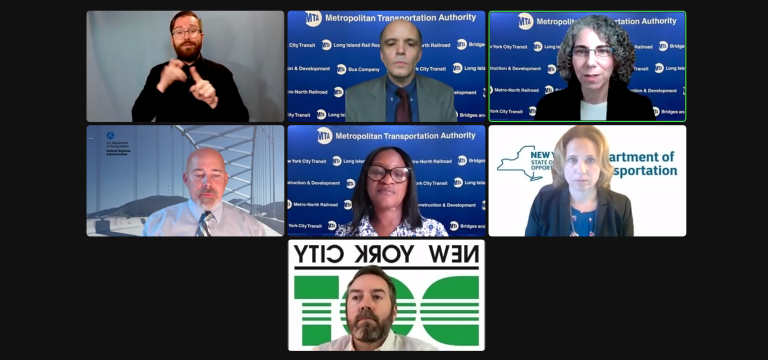
Nassau public officials and residents voiced a variety of viewpoints on what many expect to be a divisive debate during the first public hearing over the proposed Central Business District Tolling Program for drivers entering Manhattan.
The hearing began at 5 p.m. on Thursday. MTA officials said that 391 speakers from the city and surrounding areas registered for the Zoom event, which lasted almost seven hours.
During the hearing, each speaker had three minutes to share their thoughts. MTA officials on the call included Deputy Chief Operating Officer Allison C. de Cerreño and attorney Louis Oliva.
The MTA’s proposed congestion pricing plan, according to the project’s environmental assessment, could increase the daily entry fee into Manhattan. The plan calls for a toll to be paid to enter a zone that extends from 60th Street to the Battery.
State Sen. Anna Kaplan (D-North Hills) and Congresswoman Nicole Malliotakis (NY-11) kicked off the festivities.
Kaplan voiced her support for the endeavor. In particular, she said that the pandemic has made matters worse by straining the MTA’s resources and compromising recent advancements made to the Long Island Railroad.
“It’s important that we do this right so that our region can benefit from new investments with the lowest cost to Long Islanders,” she said. “The promise of 10% proceeds for the Long Island Railroad, estimated at $100 million per year, will allow for transformative investment to take place in our local infrastructures like the purchase of desperately needed new train cars and overall improvements to service and reliability for Long Island commuters.”
MTA officials expect congestion pricing to raise $1 billion per year, which would fund public transportation improvements. As Kaplan mentioned, 10% would go to the LIRR. She added she would not accept any project that does not “fulfill this promise.”
She said the tolling method the MTA should use is the one that meets the requirements for enhancing infrastructure while having the lowest costs for drivers.
“This program stands to be a huge win for our region — $1 billion invested annually in our mass transit and our subways,” said Kaplan. “But it must be reasonable for residents who are still struggling themselves due to higher costs on everyday items.”
Democrat and Brooklyn Borough President Antonio Reynoso referred to the proposal as a “win-win-win.” Beyond exceptions for emergency vehicles and those transporting persons with disabilities, he said it should proceed with as few exemptions as possible.
“I hope that the Traffic Mobility Review Board will consider conducting more outreach and holding these hearings in the fall specifically on the proposed pricing structures so that more New Yorkers will have the chance to have their voices heard,” he said. “Thank you again and please don’t forget to spread love — it’s the Brooklyn way. Peace.”
Malliotakis, a Republican, was among those on the opposing side. She said the project is being “jammed down the throats” of all New Yorkers. Her constituents include Staten Island and southern Brooklyn.
She said the city needs more time and transparency to guarantee the effects of this initiative prior to its execution. To fully understand potential consequences, she said comprehensive environmental impact research and an economic impact study are required.
“New York City is just getting back on its feet following the COVID pandemic,” she said. “We are trying to get more people to come to our city. I think that this is going to have a detrimental impact on that.”
If implemented, peak-hour travel could cost between $9 and $23. Off-peak travel could cost between $7 and $17 and overnight travel might cost between $5 and $12.
Malliotakis said the initiative is a continuation of the MTA’s “war on cars” approach and is about revenue.
“I have a very toll-sensitive community representing Staten Island,” she said. “We’re the only borough that has to pay a toll to connect to the rest of the city. I fear that this will lead to my constituents being doubled-tolled. No one should have to pay a $23 fee to connect to another borough in the city in which they live.”
Other Republicans who spoke against the proposal included Rockland County Assemblyman Mike Lawler and Staten Island City Councilman Joe Borelli. Lawler dubbed the MTA the “worst-run authority in the country, period.”
“We pay $50 million more in taxes to the MTA than services we receive,” said Lawler. “It’s totally unacceptable. Congestion pricing is nothing more than a money grant. This has been a plan to tax suburban commuters.”
Prior to the public comments, the MTA officials on hand summarized the environmental assessment of the proposal.
The Manhattan Central Business District is one of the biggest in the world. But in 2020 and 2021, in a report from INRIX, a private analytics company, the city ranked as the most congested in America.
According to the executive summary of the congestion pricing plan, the region around New York City suffers from driver congestion costs of 102 hours of wasted time per year and around $1,595 per driver annually. Between 2010 and 2019, travel speeds in the Manhattan Central Business District fell by 22% from 9.1 mph to 7.1 mph.
The environmental assessment states that over 1,262,400 of the roughly 1.5 million people who work in the Central Business District commute in. Long Island accounts for 8% of these commuters — a little over 100,000 individuals.
The congesting pricing proposal seeks to lessen traffic while generating funds for upcoming transportation improvements. Officials say these changes will have a positive impact on the environment, the economy and emergency response times.
If implemented, drivers earning less than $60,000 a year would be eligible for a tax credit.
The MTA will hold future hearings on Aug. 30-31. They will also take place on Zoom and on the MTA’s YouTube channel.






